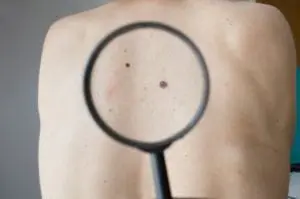Melanoma is one of the deadliest skin cancers. It begins in the melanocyte cells of your skin and can spread to other organs if not diagnosed and treated at an early stage. It may appear as a discolored and slightly raised patch with uneven borders. Some common colors include shades of black, brown, white, blue, or tan.
Melanoma Symptoms
One of the most common melanoma symptoms is lesions and moles. It can appear as a new lesion or form in an already existing mole. However, what’s worth noticing is that if it starts in an already existing mole, it usually grows on the skin’s surface before penetrating deeply.
It appears on the torso among men and on the legs among women. However, there is no limit to where else it can be found on the body. Surprisingly, melanoma is uncommon in areas protected from sun exposure, such as the scalp and buttocks.
In some cases, they have more than one color and also an irregular shape. Moles that itch or bleed are also one of the common melanoma symptoms. On the whole, never ignore a mole that gradually changes size, shape, or color.
Causes and Risk Factors
Some of the known causes of melanoma include:
- Exposure to UV (ultraviolet) light from the sun

checking melanoma on a back of a man with magnifying glass
- Sudden sun exposure that causes sunburn
Some of the known risk factors include:
- A family member who has had melanoma
- Having many freckles or moles
- Overly pale skin
- Blonde or red hair
Types of Melanoma
Superficial spreading
It is the most common type that appears on the limbs or trunk, and the cells grow slowly in the beginning before spreading on the skin’s surface.
Nodular
As the second most common type, it appears on the neck, head, or trunk. It may appear as blue-black or reddish color and can grow quicker than the other types.
Lentigo maligna
It is much less common and develops in parts of the body with excessive exposure to the sun, such as the face. Moreover, it usually develops in older adults and is less dangerous than the other types.
Acral lentiginous
This rare type of melanoma appears on the soles of the feet, palms of the hand, or beneath the nails. It is common among people with darker skin types.
How to Prevent Melanoma
Preventing melanoma is not always possible. However, you can lower the chances of developing it by avoiding getting sunburned. If you avoid instances of getting sunburned, you can also reduce your chances of developing melanoma.
You should attempt to avoid outdoor activities in broad daylight, especially if you have pale skin and several moles. However, you can ensure protection against UV rays if you invest in good sunscreens and dress sensibly. In addition, avoid sunlamps and sunbeds.
How to Treat Melanoma
Melanoma treatment depends on factors such as:
- How much cancer has spread
- The thickness of the primary melanoma
- Stage of the cancer
- Rate of growth
- Other medical conditions
Surgery
Performed by a surgical oncologist, this is the primary treatment for people with regional and local melanoma. Your healthcare professional will recommend one based on the factors stated above. The procedure mainly involves removing a tumor. Different types of surgery include:
Wide excision
A fairly common melanoma treatment for minor tumors, this procedure involves injecting anesthesia, following which the tumor site is cut out. The doctor stitches the incision, which may leave a scar.
Lymph node dissection
Also called lymphadenectomy, this melanoma treatment refers to the removal of cancerous lymph nodes. During the procedure, the doctor takes a sample of the tissue for a biopsy, looking for signs of cancer. Doctors recommend biopsies when there is evidence that cancer has spread.
Chemotherapy
Chemotherapy usually involves drugs to stop cancer growth. The drugs can either be injected into a vein or taken by mouth. Sometimes, it can also be placed in an organ, the abdomen, or the cerebrospinal fluid, depending on where the growth is taking place. The administration of chemotherapy depends on the stage and type of cancer being treated.
Radiation therapy
As the name suggests, this melanoma treatment involves radiation such as high-energy x-rays to kill cancer cells.
A common type of radiation therapy for treating melanoma is external radiation therapy. It uses a machine to send radiation to the body part with cancer.
Immunotherapy
Used to boost a person’s natural defenses against cancer, immunotherapy involves the use of substances our body produces to fight against the disease. A common type of immunotherapy for melanoma treatment is immune checkpoint inhibitor therapy.
A few types of cancer and immune cells have checkpoint proteins that keep most of your immune responses regulated. In case cancer cells contain a higher quantity of this protein, it gets hard for the immune cells to fight them. Immune checkpoint inhibitor therapy is a way to enhance the ability of immune cells to kill cancer cells.
In conclusion, melanoma is an aggressive type of skin cancer that can be life-threatening if it spreads. Therefore, keeping an eye on any potential lesions early can help you get treated in time.
The likelihood of a person surviving with melanoma is five years as compared to someone without melanoma. Therefore, early diagnosis can ensure that the five-year survival rate is 98%. However, if it spreads to lymph nodes or deeper tissues, the rate can drop to as low as 64%, and if it spreads to distant organs, the likelihood can further decrease to 23%. Therefore, it is important to get medical attention as soon as you monitor any irregular or growing moles.
SunCoast Skin Solutions Dermatology offices are located in Tampa / Hillsborough, St. Pete / Pinellas County , Brandon, Lutz, Winter Haven, Largo, Riverview, Brooksville, Ocala, and Daytona Beach, Sarasota, Punta Gorda, Seminole, Florida. Contact us at 1-844-786-3376 or click here.

Recent Comments